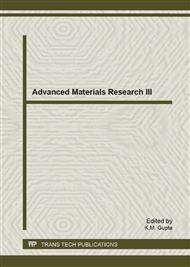p.3
p.8
p.15
p.19
p.24
p.30
p.35
p.40
On the Important Mechanical Properties of Rubber-Sand
Abstract:
More than a billion rubber tires are discarded annually around the world. Growing piles of discarded tires create fire and environmental hazards. Current disposal methods are mostly wasteful and costly. Tires possess high tensile strength, are chemically very stable, practically non-destructible and light in weight. All of these properties make tires a potentially useful geo-material. This paper presents the results of an extensive laboratory testing study investigating the potential of using shredded tires mixed with sandy soils (rubber-sand) as lightweight fill and backfill material in road construction. The results show that rubber-sand has significant promise for use as an earthwork fill material. In addition to its engineering benefits, such use of scrap tires would significantly contribute to solving the ever-growing tire disposal problem.
Info:
Periodical:
Pages:
8-14
Citation:
Online since:
April 2013
Authors:
Keywords:
Price:
Сopyright:
© 2013 Trans Tech Publications Ltd. All Rights Reserved
Share:
Citation:


